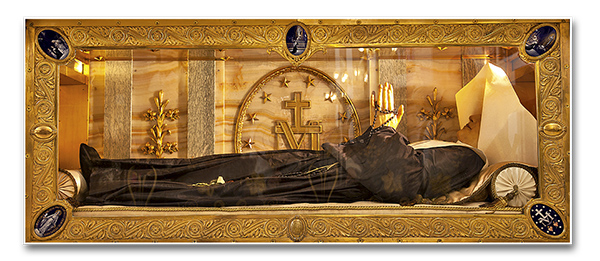The Miraculous MEdal
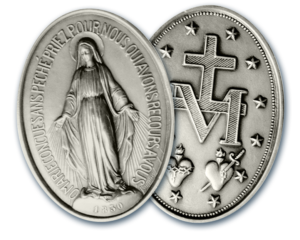
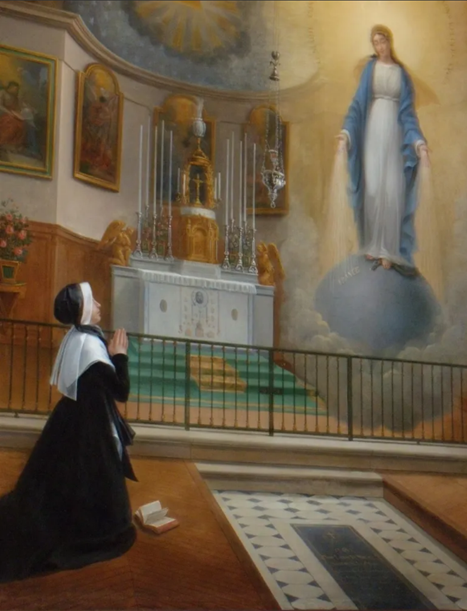
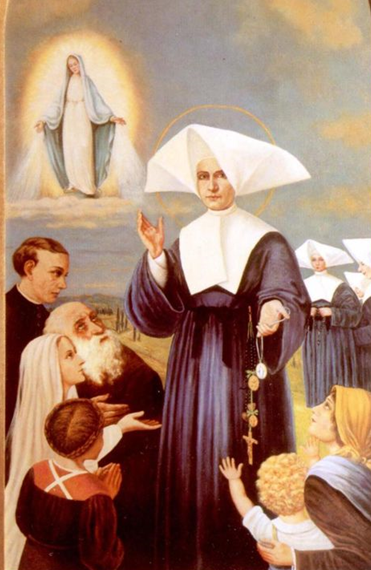
The devotion commonly known as that of the Miraculous Medal owes its origin to Zoe Labore, a member of the Daughters of Charity of St. Vincent de Paul, known in religion as Sister Catherine, to whom the Blessed Virgin Mary appeared three separate times in the year 1830, at the mother-house of the community at Paris. The first of these apparitions occurred July 18, the second November 27, and the third a short time later.
On the second occasion, Sister Catherine records that the Blessed Virgin appeared as if standing on a globe, and bearing a globe in her hands. As if from rings set with precious stones dazzling rays of light were emitted from her fingers. These, she said, were symbols of the graces which would be bestowed on all who asked for them. Sister Catherine adds that around the figure appeared an oval frame bearing in golden letters the words “O Mary, conceived without sin, pray for us who have recourse to thee”; on the back appeared the letter M, surmounted by a cross, with a crossbar beneath it, and under all the Sacred Hearts of Jesus and Mary, the former surrounded by a crown of thorns, and the latter pierced by a sword.
“Have a medal struck after this model. All those who wear it, will receive great graces especially if they wear it around the neck. Those who repeat this prayer with devotion will be in a special way under the protection of the Mother of God. Graces will be abundantly bestowed upon those who have confidence.” Our Lady during Second Apparition to St. Catherine Labouré (November 27, 1830)
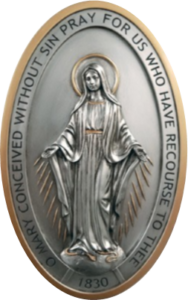
Front Side of Medal
Mary is standing upon a globe, crushing the head of a serpent beneath her foot. She stands upon the globe, as the Queen of Heaven and Earth. Her feet crush the serpent to proclaim Satan and all his followers are helpless before her (Gn 3:15). The year of 1830 on the Miraculous Medal is the year the Blessed Mother gave the design of the Miraculous Medal to Saint Catherine Labouré. The reference to Mary conceived without sin supports the dogma of the Immaculate Conception of Mary—not to be confused with the virgin birth of Jesus, and referring to Mary’s sinlessness, “full of grace” and “blessed among women” (Luke 1:28)—that was proclaimed 24 years later in 1854.
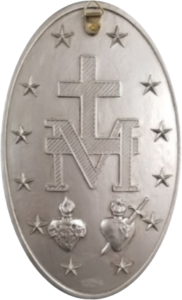
BAck Side of Medal
The twelve stars can refer to the Apostles, who represent the entire Church as it surrounds Mary. They also recall the vision of Saint John, writer of the Book of Revelation (12:1), in which “a great sign appeared in heaven, a woman clothed with the sun, and the moon under her feet, and on her head a crown of 12 stars.” The cross can symbolize Christ and our redemption, with the bar under the cross a sign of the earth. The “M” stands for Mary, and the interleaving of her initial and the cross shows Mary’s close involvement with Jesus and our world. In this we see Mary’s part in our salvation and her role as mother of the Church. The two hearts represent the love of Jesus and Mary for us. (See also Lk 2:35).
Miraculous Medal Novena Prayer
Immaculate Virgin Mary, Mother of Our Lord Jesus and our Mother, penetrated with the most lively confidence in thy all-powerful and never failing intercession, manifested so often through the Miraculous Medal, we, thy loving and trustful children, implore thee to obtain for us the graces and favors we ask during this Novena, if they be beneficial to our immortal souls, and the souls for whom we pray. (Here privately form your petitions.) You know, O Mary, how often our souls have been sanctuaries of thy Son, who hates iniquity. Obtain for us, then, a deep hatred of sin and that purity of heart which will attach us to God alone, so that our every thought, word and deed may tend to His greater glory. Obtain for us also a spirit of prayer and self-denial, that we may recover by penance what we have lost by sin, and at length attain to that blessed abode where thou art the Queen of angels and of men. Amen.
